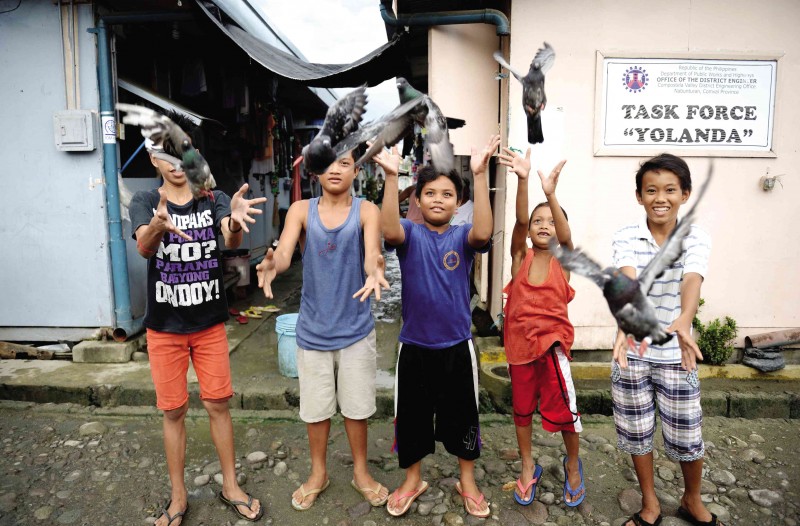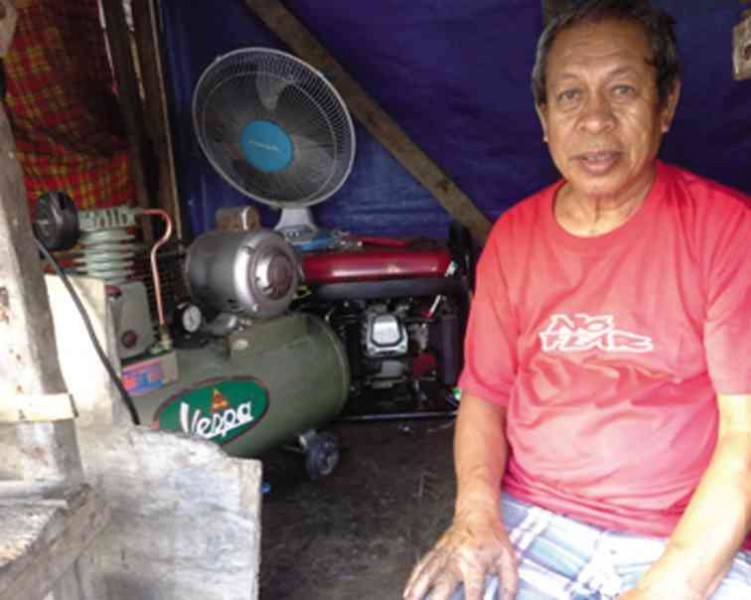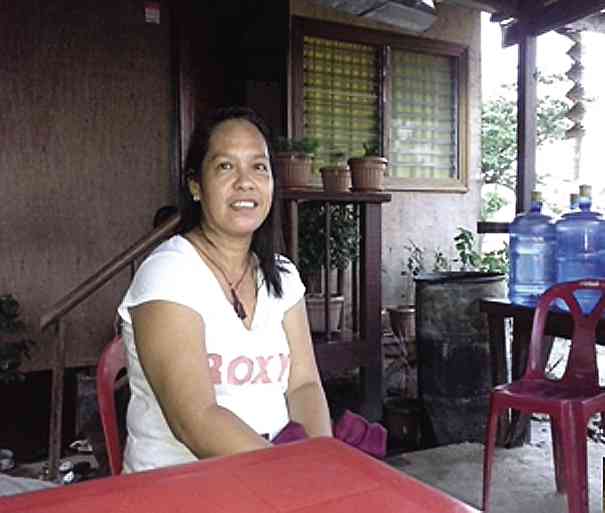Preparedness of ‘Yolanda’ survivors

TWO YEARS AFTER ‘YOLANDA’ Boys releasing pet pigeons at a temporary shelter for survivors of Supertyphoon “Yolanda” (international name: Haiyan) in Tacloban City. AFP
WITH the distressing memory of Supertyphoon “Yolanda” (international name: Haiyan) coming back time and again, there is a need to look at how survivors in Tacloban City rebuilt from ground zero and what they have done to prepare for any impending disaster.
Lourdes Codillan, 70, a traditional healer of Barangay 54 Magallanes, survived but her son, daughter-in-law and five grandchildren drowned at the evacuation site at San Fernando Elementary School during the storm surge on Nov. 8, 2013.
She was barely alive, buried in mud and debris, when rescuers found her in the evacuation center.
Cash for work
After the typhoon, Lourdes took part in the cash-for-work program of Tzu Chi Foundation, collecting debris in the streets of Magallanes.
The foundation gave her P3,900 to sustain her basic needs and support her three granddaughters. From her earnings, she used P1,500 as an initial capital for her sari-sari store.
House rebuilt
After staying for three months at the evacuation center, she was able to rebuild her house, made of light materials. Her earnings in the cash-for-work program and contributions from her neighbors made rebuilding her house possible.
For one year, Lourdes was able to survive on abundant supply of relief goods from government and nongovernment organizations.
Asked about what preparations she would make in case another typhoon like Yolanda strikes the city, she said, “We will go to the nearest evacuation site upon knowing that there is a typhoon, bringing clothing and food.”
Rogelio Abordo, 58, of Barangay 66-A Anibong is another survivor. With his six children, he ran up the hill at the back of their house when the surge reached knee-deep.
Their house was destroyed by a container van that struck it during the surge.
They reconstructed their small house from materials scattered all over the neighborhood and improved it with P30,000 he received from the government’s Emergency Shelter Assistance.
Like Codillan, he participated in the Tzu Chi Foundation cash-for-work program along with six members of his family. Each of them was paid P500 a day clearing their area of debris.
After seven days of work, they earned a total of P28,000, which they used to buy a generator set worth P15,000 and an air compressor worth P6,000 to restore his vulcanizing shop.
Evacuate to hill
In case there is another typhoon, Rogelio said, “We will evacuate to the hill and bring food good for four to five days.”
While nothing can be done to prevent the occurrence of a typhoon as violent as Yolanda, there is much that can be done to prepare families to meet disasters posed by a typhoon.
Survey
These experiences are excerpts from interviews during a three-month survey of 395 households in Barangays Anibong, San Jose, Sagkahan and Magallanes District—coastal and flood-prone areas of Tacloban.
In the survey only 3.6 percent had family disaster plans and 16.1 percent had emergency kits. How many had supply of food, water and medicine for three days? Just 36.5 percent. (See Figure 1.)
On the positive side, 81.1 percent have an idea where they would go in case they have to leave their homes. They will go to relatives in a safer area or move to safe ground far from the coast.
The interviews found that 85.6 percent could not determine the strongest part of their houses where they could take cover if a typhoon comes, largely because all of them live in temporary shelters made of wood and other light materials.
Only 3 of the 395 respondents had emergency life-saving equipment.
But 89.7 percent had flashlights, 77.6 percent had radios to monitor weather conditions mainly through cell phone, 81.1 percent knew where the nearest evacuation center was located should they be instructed to leave their residence.
Whistle
When Angeline Go, 38, of Barangay 56-A Old Road Sagkahan, was asked about what a family should do before the incoming disaster, she said, “Every family should have a whistle, solar-powered radio, medical kit, raincoat, blanket for the children, emergency contact number and a poster that can be placed inside the house showing what each member of the family will do before, during and after the calamity.”
In addition to the insights of the respondents, every family must develop and practice disaster preparedness plans which include the following:
Determining the disaster most likely to affect the household
Identifying the escape routes from the home and meeting place of the family members in case they are separated by a disaster
Listing emergency contact numbers for communicating with each other
Preparing disaster kits, family medical and financial information, and mode of sharing and maintaining the plan.
Life-saving equipment
Also, family members can undergo training in first aid and community response program as well as development of low-cost, life-saving equipment.
Schools can intensify the integration of disaster risk reduction management in their curricula and offer it as a subject or course to broaden students’ understanding on disaster preparedness and do their part in resiliency building.
“We will evacuate instantaneously without being told to do so,” said Mario Lago, 61, a fisherman of Barangay 89, San Jose.
To evacuate immediately is just but one measure in disaster preparedness. More comprehensive actions are needed to guarantee the safety of everyone.
(Mary Jean P. Yanger is an assistant professor at Eastern Visayas State University in Tacloban City, Leyte. She can be reached at [email protected].)

















